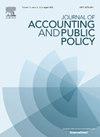Significant expected lifetime credit loss impairments: Determinants of bank loss recognition and stability implications
IF 2.2
3区 管理学
Q1 BUSINESS, FINANCE
引用次数: 0
Abstract
This paper explores how a recognition threshold approach for significant expected lifetime credit losses (ELCL) affects the joint surplus of a bank's debtholders and shareholders (bank social value). Banks play a dual role in the economy by supplying credit to the real sector and providing liquidity to depositors. Information released on ELCL induces sound risk-taking in credit supply while potentially distorting the bank's liquidity provision. A recognition threshold for ELCL can balance these social gains and costs by restricting ELCL recognition for a transaction to extreme outcomes. In this balancing act, the recognition threshold enhances a bank's social value by providing sufficient incentives for sound risk-taking while decreasing the social costs of liquidity disruption. Less favorable economic conditions necessitate tighter recognition thresholds to sustain sound risk-taking, which inflates the social costs of liquidity disruption. When these costs become excessive, the balance is disrupted, and forgoing ELCL recognition can enhance the bank's social value. While this practice safeguards stability in the short run, it ultimately undermines it in the long run. From a policy perspective, the results highlight the value of the principle-based notion of IFRS 9's significant increase in credit risk (SICR) criterion to address bank-specific trade-offs and increase a bank's social value. Uniformity of recognition thresholds can be demonstrated for at least a subset of banks. Lastly, the paper emphasizes that a recognition threshold approach does not maximize the social value of a bank, and more complex disclosure rules can further increase it.
重大预期终身信贷损失减值:银行损失确认和稳定性影响的决定因素
本文探讨了重大预期终身信贷损失(ELCL)的确认阈值方法如何影响银行债权人和股东的共同盈余(银行社会价值)。银行在经济中扮演着双重角色,一方面向实体部门提供信贷,另一方面向储户提供流动性。有关ELCL的信息发布,在可能扭曲银行流动性供应的同时,在信贷供应方面引发了合理的冒险行为。ELCL的识别阈值可以通过将交易的ELCL识别限制为极端结果来平衡这些社会收益和成本。在这种平衡行为中,认可门槛通过为合理的冒险行为提供足够的激励,同时降低流动性中断的社会成本,从而提高银行的社会价值。不太有利的经济条件需要更严格的认可门槛,以维持稳健的冒险行为,这将放大流动性中断的社会成本。当这些成本变得过高时,平衡就会被打破,放弃对ELCL的认可可以提高银行的社会价值。虽然这种做法在短期内维护了稳定,但从长远来看,它最终会破坏稳定。从政策角度来看,结果突出了IFRS 9的信用风险显著增加(SICR)标准的基于原则概念的价值,以解决银行特定的权衡并增加银行的社会价值。识别阈值的一致性至少可以在银行的一个子集中得到证明。最后,本文强调了识别阈值方法并不能使银行的社会价值最大化,更复杂的披露规则可以进一步提高银行的社会价值。
本文章由计算机程序翻译,如有差异,请以英文原文为准。
求助全文
约1分钟内获得全文
求助全文
来源期刊

Journal of Accounting and Public Policy
Multiple-
CiteScore
4.80
自引率
2.80%
发文量
75
期刊介绍:
The Journal of Accounting and Public Policy publishes research papers focusing on the intersection between accounting and public policy. Preference is given to papers illuminating through theoretical or empirical analysis, the effects of accounting on public policy and vice-versa. Subjects treated in this journal include the interface of accounting with economics, political science, sociology, or law. The Journal includes a section entitled Accounting Letters. This section publishes short research articles that should not exceed approximately 3,000 words. The objective of this section is to facilitate the rapid dissemination of important accounting research. Accordingly, articles submitted to this section will be reviewed within fours weeks of receipt, revisions will be limited to one, and publication will occur within four months of acceptance.
 求助内容:
求助内容: 应助结果提醒方式:
应助结果提醒方式:


